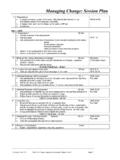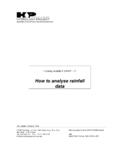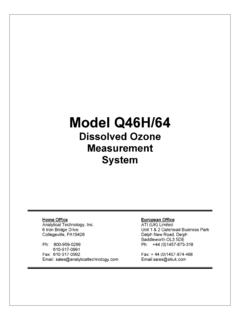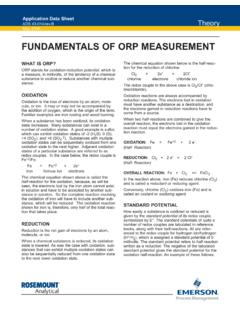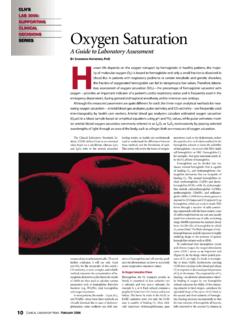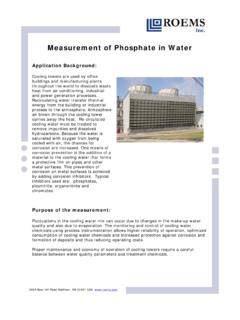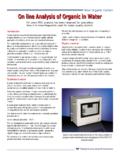Transcription of Understanding the chemistry of dissolved oxygen (DO ...
1 World Bank & Government of The Netherlands fundedTraining module # WQ - 11 The chemistry of dissolved oxygen measurementNew Delhi, May 1999 CSMRS Building, 4th Floor, Olof Palme Marg, Hauz Khas,New Delhi 11 00 16 IndiaTel: 68 61 681 / 84 Fax: (+ 91 11) 68 61 685E-Mail: Consultants BV & DELFT HYDRAULICS withHALCROW, TAHAL, CES, ORG & JPSHP Training Module File: 11 chemistry of DO Version 05/11/02 Page 1 Table of contents1 Module context22 Module profile33 Session plan44 Overhead/flipchart master55 Evaluation sheets296 Handout317 Additional handout388 Main text39HP Training Module File: 11 chemistry of DO Version 05/11/02 Page 21 Module contextThis module deals with significance and chemistry of dissolved oxygen in which prior training is required to complete this module successfully and otheravailable, related modules in this category are listed in the table designing a training course, the relationship between this module and the others, wouldbe maintained by keeping them close together in the syllabus and place them in a logicalsequence.
2 The actual selection of the topics and the depth of training would, of course,depend on the training needs of the participants, their knowledge level and skillsperformance upon the start of the titleCodeObjectives1 Basic water qualityconceptsWQ - 01 Discuss the common waterquality parameters List important water quality issues2 Basic chemistry conceptsWQ - 02 Convert units from one to another Discuss the basic concepts ofquantitative chemistry Report analytical results with thecorrect number of to prepare standardsolutionsWQ - 04 Select different types ofglassware Use an analytical balance andmaintain it. Prepare standard to measure dissolvedoxygenWQ - 12 Collect water sample formeasurement of dissolved oxygen Determine the quantity ofdissolved oxygenHP Training Module File: 11 chemistry of DO Version 05/11/02 Page 32 Module profileTitle:The chemistry of dissolved oxygen (DO) measurementTarget group:HIS function(s): Q1, Q2, Q3, Q5 Duration:1 session of 90 minObjectives:After the training the participants will be able to: Appreciate significance of DO measurement Understand the chemistry of DO measurement byWinkler methodKey concepts: Significance Solubility of oxygen Sampling chemistry of Winkler methodTraining methods:Lecture, demonstration, exercises and open discussionTraining toolsrequired:OHSH andouts:As provided in this moduleFurther readingand references: Analytical chemistry : An introduction, Skoog and West/1986.
3 Saunders College Publishing chemistry for Environmental Engineering, Sawyer, McCarty and Parkin. McGraw-Hill, 1994HP Training Module File: 11 chemistry of DO Version 05/11/02 Page 43 Session planNoActivitiesTimeTools1 Preparations2 Introduction: Introduce the subject of dissolved oxygen ,explain its significance Explain aerobic and anaerobic decompositionprocess in polluted water body. Explain minimum standard requirements fornormal aquatic life in natural water body5 minOHSOHSOHS3 Solubility of oxygen Explain solubility of oxygen in water as afunction of temperature, salinity and partialpressure Demonstrate how to calculate the saturated DOlevel at a given temperature and pressure usingtext Table 1, text section Ask participants to practice calculating thesaturated DO and storage of samples Explain the precautions in collection and storageof samples Demonstrate the use of the DO sampler, textsection sampler5 Winkler Method Explain the chemistry of Winkler method Explain how nitrite interference is eliminated withazide modification, text section solutions Ask participants meaning of secondary standardsolution (sodium thio-sulphate).
4 Explain (in short)the meaning of primary & secondary standardsused in titrimetric methods. Demonstrate how to calculate the exact normalityof given sodium thio-sulphate Summarise the session Clarify doubts5 Training Module File: 11 chemistry of DO Version 05/11/02 Page 54 Overhead/flipchart masterOHS format guidelinesType of textStyleSettingHeadings:OHS-TitleArial 30-36, Bold with bottom border line (not:underline)Text:OHS-lev1 OHS-lev2 Arial 26,Arial 24, with indentmaximum two levels onlyCase:Sentence case. Avoid full text in :Use occasionally and in a consistent wayListings:OHS-lev1 OHS-lev1-NumberedBig for definite series of steps. Avoidroman numbers and :None, as these get lost in photocopying andsome colours do not reproduce at of a table will ease alignment over morelines (rows and columns)Use equation editor for advanced formattingonlyHP Training Module File: 11 chemistry of DO Version 05/11/02 Page 6 dissolved oxygen :1.
5 dissolved oxygen : significance2. Why measure DO?3. Standards: minimum oxygen in surface water4. Solubility of oxygen5. dissolved oxygen sampler6. Determining DO: Winkler method7. Winkler method: chemistry8. Standard solutionsHydrology Project Training Module File: 11 chemistry of DO Version 05/11/02 Page 7 dissolved oxygen : significance Well-being of fish & normal aquatic life in natural surface water Aerobic decomposition of organic matter in polluted watersHydrology Project Training Module File: 11 chemistry of DO Version 05/11/02 Page 8 Why measure DO To indicate health of a water body To monitor & operate aerobic waste water treatment plants To prevent corrosion in water treatment & distribution systemsHydrology Project Training Module File: 11 chemistry of DO Version 05/11/02 Page 9 Surface Water Standards Drinking water source without conventional treatment,after mg/L Drinking water source with conventional treatment,followed by mg/L Out-door mg/L Fish culture and wild life mg/LHydrology Project Training Module File.
6 11 chemistry of DO Version 05/11/02 Page 10 Solubility of oxygenSee Table of saturation levels in handoutHydrology Project Training Module File: 11 chemistry of DO Version 05/11/02 Page 11 Solubility of oxygen For saturation at other pressuresP - pC s=Csx----------760 - pWhere:C s = Solubility at barometric pressure P & given temp, inmg/LCs = Saturation at given temp from table, mg/LP = Barometric pressure, mmp = Pressure of saturated water vapour at temperatureof the water selected from Table 1, mmHydrology Project Training Module File: 11 chemistry of DO Version 05/11/02 Page 12 Solubility of oxygen : exampleT = 28 C, P = 710 mm, Cl- = 600 mg/L, DO = mg/L1. Calculate the saturation DO2. Calculate percent saturation level. From the table:Cs at 0 mg/L Cl- = mg/LCs decreases mg/100 mg Cl-p = 28 mm HgHydrology Project Training Module File: 11 chemistry of DO Version 05/11/02 Page 13 Solubility of oxygen : example Correction for Cl-Cs= - ( x 6)= mg/L Correction for pressureP - pC s=Csx----------760 - p710 - 28C s= mg/L760 - 28 Hydrology Project Training Module File: 11 chemistry of DO Version 05/11/02 Page 14 Solubility of oxygen : exampleSaturation DO concentration is mg/L If sample DO concentration is mg/L percent saturation = saturation=-------=79 % Project Training Module File: 11 chemistry of DO Version 05/11/02 Page 15 Solubility of oxygen : exerciseCalculate the saturation DO level in water containing 2000 mg/Lchloride at 26 C at 720 mm barometric pressure.
7 What is thepercent saturation level if the DO content is Training Module File: 11 chemistry of DO Version 05/11/02 Page 16 dissolved oxygen samplerWater inletAir outletDOWeightHP Training Module File: 11 chemistry of DO Version 05/11/02 Page 17 Winkler methodBased on:1. Reactions: releasing iodine = oxygen present in sample2. Titration of liberated iodineHydrology Project Training Module File: 11 chemistry of DO Version 05/11/02 Page 18 Winkler methodStep 1 Determine presence of oxygenStep 2 Oxidise iodide to form iodineStep 3 Titrate iodine till pale straw colourStep 4 Change colour to blueStep 5 Titrate till solution is colourlessStep 6 Note the final readingHydrology Project Training Module File: 11 chemistry of DO Version 05/11/02 Page 19 Winkler methodStep 1 Add manganese sulphate & alkali iodide reagents If no oxygen is present:Mn++ + 2OH- = Mn (OH)2white manganese hydroxide If oxygen is present:Mn++ + 2OH- + O2 = MnO2+H2 Obrown manganese dioxideHydrology Project Training Module File: 11 chemistry of DO Version 05/11/02 Page 20 Winkler methodAdd sulphuric + 4H+ + 2 I- = Mn++ + I2 + 2H2 OIodine is formed by oxidation of iodideHydrology Project Training Module File.
8 11 chemistry of DO Version 05/11/02 Page 21 Winkler methodStep 3 Titrate liberated iodine with sodium thio-sulphate standardsolution2 Na2 S2 O3 + I2 = Na2 S4 O6 + 2 NaIObserve colour change to pale strawHydrology Project Training Module File: 11 chemistry of DO Version 05/11/02 Page 22 Winkler methodStep 4 Add starch indicatorcolour changes to blueStep 5 Continue titrationtill solution becomes colourlessStep 6 Note the final readingHydrology Project Training Module File: 11 chemistry of DO Version 05/11/02 Page 23 Nitrite interference & azide modificationNitrite in water samples causes interference by oxidising iodideas:2 NO-2 + 2 I- + 4 H+ = I2 + N2O2 + 2 H2ON2O2 then oxidised by oxygen entering sample during titration:N2O2 + O2 + H2O = 2 NO-2 + 2 H+Results in erroneous high end point value not possibleHydrology Project Training Module File: 11 chemistry of DO Version 05/11/02 Page 24 Nitrite interference & azide modificationIn azide modification, sodium azide NaN3 added with alkalireagent.
9 Destroys nitrite, if present:NaN3 + H+ = HN3 + Na+HN3 + NO2 + H+ = N2 + N2O + H2 OHydrology Project Training Module File: 11 chemistry of DO Version 05/11/02 Page 25 Standard solutions Primary standard solution: Potassium dichromateK2 Cr2 O7 Potassium IodateK I O3 Potassium hydrogen bi-iodate KH (IO3)2 Secondary standard solution: Sodium thio-sulphate Project Training Module File: 11 chemistry of DO Version 05/11/02 Page 26 Standardising secondary standard Primary standards react with iodide ionCr2O7-- + 6I- + 14H+ = 2Cr+++ + 3I2 +7H2 OIO3- + 5 I- + 6 H+ = 3 I2 + 3 H2O The released iodine is titrated with secondary standard2 Na2 S2O3 + I2 = Na2 S4O6 + 2 Na IHydrology Project Training Module File: 11 chemistry of DO Version 05/11/02 Page 27 Standard solutions: example calculationsRefer to handoutHydrology Project Training Module File: 11 chemistry of DO Version 05/11/02 Page 28 dissolved oxygen : summary Significance: monitor normal aquatic life Indian standard specify min of mg/L Solubility of oxygen depends on partial pressure, temperature& salinity of water Avoid aeration of water during collection, use the DO sampler.
10 Eliminate nitrite interference, use azide modification Liberated iodine equal to DO Primary standard: use potassium dichromate or bi-iodate Secondary standard: use sodium thio-sulphateHP Training Module File: 11 chemistry of DO Version 05/11/02 Page 295 EvaluationHP Training Module File: 11 chemistry of DO Version 05/11/02 Page 30 QuestionsQ20 mL of N potassium bi-iodate was reacted with excess iodide andsulphuric acid. The released iodine was titrated with a sodium thio-sulphatesolution.(a)Calculate the normality of thio-sulphate solution if mL solution was used inthe titration.(b)What volumes of the solution and distilled water should be mixed to prepare250 mL of N standard the normality of KH (IO3)2 solution containing mg/I used toliberate iodine from the significance of DO the DO in a sample of water if mL of sodium thiosulphate solution was used while titrating 200 mL of sample treated according to Winkler s methodTrue or false: Organic pollution of surface waters results in decrease of DO Absence of oxygen in surface waters results in production of odorous compounds Good quality groundwater is always saturated with DO Presence of nitrite in water will result in over estimation of DO if azidemodification is Training Module File: 11 chemistry of DO Version 05/11/02 Page 316 HandoutsHP Training Module File: 11 chemistry of DO Version 05/11/02 Page 32 dissolved oxygen :1.


